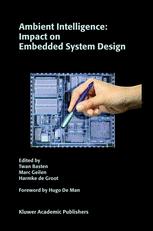

Most ebook files are in PDF format, so you can easily read them using various software such as Foxit Reader or directly on the Google Chrome browser.
Some ebook files are released by publishers in other formats such as .awz, .mobi, .epub, .fb2, etc. You may need to install specific software to read these formats on mobile/PC, such as Calibre.
Please read the tutorial at this link: https://ebookbell.com/faq
We offer FREE conversion to the popular formats you request; however, this may take some time. Therefore, right after payment, please email us, and we will try to provide the service as quickly as possible.
For some exceptional file formats or broken links (if any), please refrain from opening any disputes. Instead, email us first, and we will try to assist within a maximum of 6 hours.
EbookBell Team

4.0
26 reviewsHugo de Man Professor Katholieke Universiteit Leuven Senior Research Fellow IMEC The steady evolution of hardware, software and communications technology is rapidly transforming the PC- and dot.com world into the world of Ambient Intelligence (AmI). This next wave of information technology is fundam- tally different in that it makes distributed wired and wireless computing and communication disappear to the background and puts users to the foreground. AmI adapts to people instead of the other way around. It will augment our consciousness, monitor our health and security, guide us through traffic etc. In short, its ultimate goal is to improve the quality of our life by a quiet, reliable and secure interaction with our social and material environment. What makes AmI engineering so fascinating is that its design starts from studying person to world interactions that need to be implemented as an int- ligent and autonomous interplay of virtually all necessary networked electronic intelligence on the globe. This is a new and exciting dimension for most elect- cal and software engineers and may attract more creative talent to engineering than pure technology does. Development of the leading technology for AmI will only succeed if the engineering research community is prepared to join forces in order to make Mark Weiser’s dream of 1991 come true. This will not be business as usual by just doubling transistor count or clock speed in a microprocessor or increasing the bandwidth of communication.